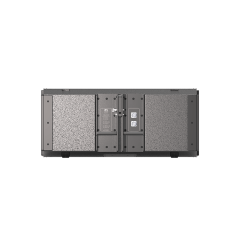Deploying a line array system with better efficiency can be concluded by the planning of that allocation, ( placement) in addition to configuring them electronically. The objective is to provide uniform coverage of the approved A-band in order to obtain flawless and undistorted sound quality with maximum dynamics throughout the entire audience area. Examples of this are speaker placement, tuning and examples with advanced audio processing technology.
It is important that the line array system be deployed correctly for best performance. The heights and angles of the speakers modules require extremely precise calculations so that sound distribution is uniform. A typical line array system provides 90-degree horizontal and one tenth or less of a degree vertical coverage, enabling sound to be projected over long throws without significant dropoff. Simulation software is useful in predicting how sound will behave within a specfic space, which can allow engineers to choose what placement they want with some confidence.
The purpose of tuning a line array system is to make its frequency response adapt to one particular space. Usually this involves some kind of EQ to make sure everything sounds even across the frequency spectrum. In many cases top-of-the-line line array systems utilize DSP (Digital Signal Processing) technology to help further command the audio signal. For example, in a concert situation the DSP equalization can be automatically adjusted second by second for delay and phase etc., as part of keeping one sound consistent.
Another important key to line array system numerical optimization is power management. Every individual speaker module has, of course to have enough power/ energy for them in order to work at a particular volume completely devoid from any distortion. Matching the power requirements of speakers with a system's amplifiers is vital in preservation to sound quality. For instance, a concert venue using line array systems for large performances would necessitate amplifiers capable of delivering as much as 1,000 watts per channel to provide sufficient power output levels and sound pressure.

Calibration and Testing Calibration and testing are important steps in the optimization process. Doing a sound check in advance of an event is important because it gives engineers the opportunity to spot and correct any potential problems; for example, feedback or phase cancellation. An RTA will assist in monitoring frequency response and subsequently healing them to improve sound clarity, balance. This will make that the audience hears your song at its best.
Environmental: As with any loudspeaker system design, taking account of environmental factors is imperative when optimizing a line array system. Sound propagation is sensitive to temperature, humidity and wind. Given this variability, many systems incorporate subcategories that the user can adjust to make sure sound coverage remains consistent. If you're doing an outdoor performances or meeting using microphones, don't forget about weatherproofing or windshields for the mic to keep damage and reduce noise (if not picking up sound from unintended/undesired sources better than they should be based on where you are).
What you put in matters, whether regarding the quality of speaker components or a line array system. Opting for a reputed brand that makes high-quality, long lasting audio equipment can get you a good value of your money spent. The best line array systems are built tough enough to bear the brunt of live performance and incorporate top-end technology that is going to help you deliver outstanding sound, regardless of how big your party may get.
Line array systems have continued to evolve and improve, adding new capabilities that boost its performance with the advancement of technology. Of course, with more advances such as networked audio pathing, wireless control and AI supported tweaks standing up to make their voices heard we are in an age where the sound engineer is being given a few extra toys in his toy box. We've seen and heard the things we like. More importantly, each of these advancements during setup as well in operation that sounds even better which cuts down time at every step from installation to listening:
Audiomastering legend Bob McCarthy, said very wisely that 'The great sound requires understanding of the science behind art' His method emphasizes the need to marry technical know-how with hands-on experience in order to achieve optimal outcomes. Utilizing a combination of technological developments and knowledge from the experts, sound engineers can maximize their line arrays for that ultimate audio experience.
If you need more information about line array system optimization, have a look with the web pages internet in this article for resources and specialist suggestions.